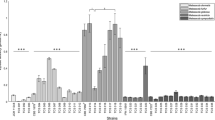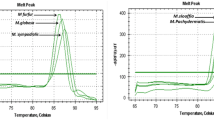Abstract
One hundred and twenty lipid dependent Malassezia spp. isolates were obtained from the clinically normal skin of 38 healthy adult volunteers by swabbing three different body sites (back, chest and scalp). Ninety-six percent of these strains could be grouped into three biotypes on the basis of microscopic, cultural, metabolic and biochemical (catalase, esculin and lipase (C-14)) characteristics. The differential features were simple to determine and easily reproduced. Moreover, the three biotypes were referable to the species M. globosa (biotype 1), M. sympodialis (biotype 2) and M. restricta (biotype 3). Based on their microscopic features, cultural properties and body site locations, we suggest that biotype 1/ M. globosa corresponds to the description of Pityrosporum orbiculare (round yeast cells with a narrow base, very frequently found on the upper trunk), and biotype 3/ M. restricta corresponds to the concept of P. ovale (oval yeast cells with a broad budding base, located mainly on the scalp). Pleomorphic biotype 2/ M. sympodialis, most frequently found in the back, does not clearly fit into any of the Pityrosporum species.
Similar content being viewed by others
References
Kreger-van Rij NJW. General classification of the yeasts. In: NJWKreger-van Rij, ed. The Yeasts: A Taxonomic Study, 3rd edn. Elsevier Science Publishers, Amsterdam, 1984: 1–44.
Yarrow D, Ahearn DG. Genus 7: Malassezia Baillon. In: NJW Kreger-van Rij, ed. The Yeasts: A Taxonomic Study, 3rd edn. Elsevier Science Publishers, Amsterdam, 1984: 882–885.
Simmons RB, Ahearn DG. Cell wall ultrastructure and DBB reaction of Sporopachydermia quercuum, Bullera tsugae and Malassezia spp. Mycologia 1987; 79: 38–43.
Guého E, Meyer SA. A reevaluation of the genus Malassezia by means of genome comparison. Antonie van Leeuwenhoek 1989; 55: 245–251.
Warren NG, Hazen KC. Candida, Cryptococcus, and other yeasts. In: Murray PR, Baron EJ, Pfaller MA, Tenover FC, Yolken RH, eds. Manual of Clinical Microbiology, 6th ed. ASM Press, Washington DC, 1995: 733–734.
Kwon-Chung KJ, Bennett JE. Infections caused byMalassezia species. In: Lea & Febiger, Medical Mycology, Philadelphia, 1992: 170–182.
De Hoog GS, Guano J, Tan CS, Wintermans RGF, Gene J. Pathogenic Fungi and Common Opportunists Yeasts. In: De Hoog GS, Guarro J, eds. Atlas of Clinical Fungi. Centraalbureau voor Schimmelcultures and Universitat Rovira i Virgili, Baarn, The Netherlands, 1995: 212.
Sloof WC. Genus 6: Pityrosporum Sabouraud. In: Lodder J, ed. The Yeasts: A Taxonomie Study, 2nd edn. North-Holland, Amsterdam, 1970: 1167–1186.
Tanaka M, Imamura S. Immunological studies on Pityrosporum genus and Malassezia furfur. J Invest Dermatol 1979; 73: 321–324.
Gordon, MA. The lipophilic mycoflora of the skin. In vitro culture of Pityrosporum orbiculare. Mycologica 1951; 43: 524–535.
Roberts SOB. Pityrosporum orbiculare: incidence and distribution on clinically normal skin. Br J Dermatol 1969; 81: 264–269.
Martin-Scott I. The Pityrosporum ovale. Br J Dermatol 1952; 64: 257–273.
Randjandiche M. Polimorphisme de Pityrosporum ovale (Bizzozero) Castellani & Chalmers in vivo or in vitro. Bull Soc Fr Mycol Med 1976; 5: 79–84.
Salkin IF, Gordon M. Polymorphism inMalassezia furfur. Can J Microbiol 1977; 23: 471–475.
Takahashi M, Ushijima T, Okazi Y. Comparative studies on biochemical and serological characteristics of each species of Pityrosporum. Jpn J Med Mycol 1981; 22: 314–321.
Midgley G. The diversity of Pityrosporum (Malassezia) yeasts in vivo and in vitro. Mycopathologia 1989; 106: 143–153.
Cunningham AC, Leeming JP, Ingham E, Gowland G. Differentiation of three serovars of Malassezia furfur. J Appl Bacteriol 1990; 68: 439–446.
Boeckhout T, Renting M, Scheffers A, Bosboom R. The use of karyotyping in the systematics of yeasts. Antonie van Leeuwenhoek 1993; 63: 157–163.
Howell SA, Quin C, Midgley G. Karyotypes of oval cell forms of Malassezia furfur. Mycoses 1993; 36: 263–266.
Guillot J, Guého E. The diversity of Malassezia yeasts confirmed by RNA sequence and nuclear DNA comparisons. Antonie van Leeuwenhoek 1995; 67: 297–314.
Simmons RB, Guého E. A new species of Malassezia. Mycol Res 1990; 94: 1146–1149.
Guého E, Midgley G, Guillot J. The genus Malassezia with description of four new species. Antonie van Leeuwenhoek 1996, 69: 337–355.
Ingham E, Cunningham AC. Malassezia furfur. J Med Vet Mycol 1993; 31: 265–288.
Leeming J, Notman FH. Improved methods for isolation and enumeration of Malassezia furfur from human skin. J Clin Microbiol 1987; 25: 2017–2019.
Keyworth N, Millar MR, Holland KT. Swab-wash method for quantitation of cutaneous microflora. J Clin Microbiol 1990; 28: 941–943.
Faergemann J, Aly R, Maibach HI. Quantitative variation in distribution of Pityrosporum orbiculare on clinically normal skin. Acta Derm Venereol (Stockh) 1983; 63: 346–348.
Moreno LA, Rezusta A, Rubio-Calvo MC. Malassezia genus: Morphologic and biochemical characters. Preliminary study. XI Congress of the International Society for Human and Animal Mycology. Montréal, 1991. PS2.44.
Guillot J, Guého E, Lesourd M et al. Identification of Malassezia species. A practical approach. J Mycol Med 1996; 6: 103–110.
Shifrine M, Marr AG. The requirement of fatty acids by Pityrosporum ovale. J Gen Microbiol 1963; 32: 263–270.
Nazzaro-Porro M, Passi S, Caprilli F, Nazzaro P, Morpurgo G. Growth requirements and lipid metabolism of Pityrosporum orbiculare. J invest Dermatol 1976; 60: 178–182.
Bhandaya M. The distribution of Malassezia furfur and Malassezia pachydermatis on human normal skin. South74 east Asian J Trop Med Public Health 1993; 24: 343–346.
Ashbee HR, Ingham E, Holland KT, Cunliffe WJ. The carriage of Malassezia furfur serovars A, B and C in patients with pityriasis versicolor, seborrhoeic dermatitis and controls. Br J Dermatol 1993; 129; 533–540.
Rights and permissions
About this article
Cite this article
Aspiroz, C., Moreno, LA., Rezusta, A. et al. Differentiation of three biotypes of Malassezia species on human normal skin. Correspondence with M. globosa, M. sympodialis and M. restricta. Mycopathologia 145, 69–74 (1999). https://doi.org/10.1023/A:1007017917230
Issue Date:
DOI: https://doi.org/10.1023/A:1007017917230




